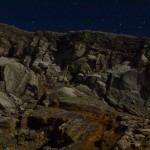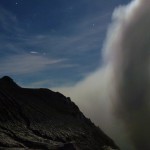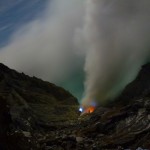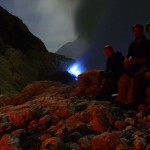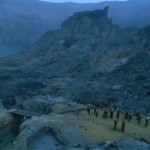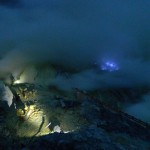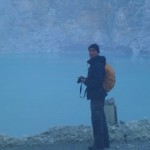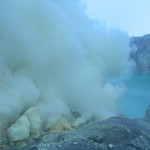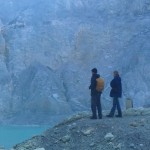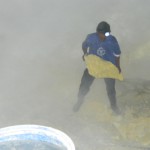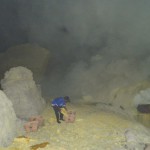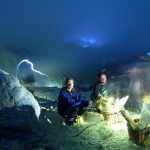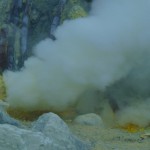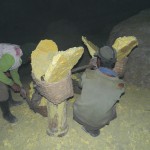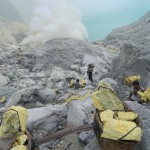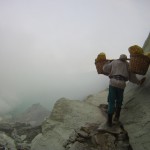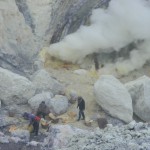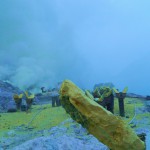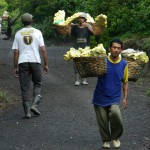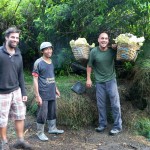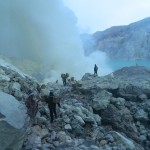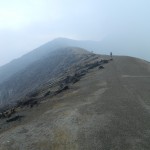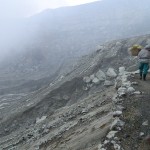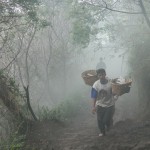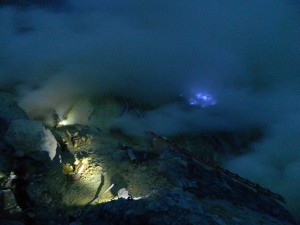 It began with the alarm at two a.m. We were the first to tackle the ascent from Pos Paltuding to Kawah Ijen, active volcano crater and source of raw sulfur in east Java.
It began with the alarm at two a.m. We were the first to tackle the ascent from Pos Paltuding to Kawah Ijen, active volcano crater and source of raw sulfur in east Java.
Already the day before we had observed the miners carrying their baskets, connected with a wooden stick across their shoulders and loaded with at least 60, but up to 100 kg of the yellow substance. They carry this unbelievably heavy and uncomfortable load two to three times per day. This means one long hour of hiking first up the crater and then down through the forest to earn three to five euros per load.
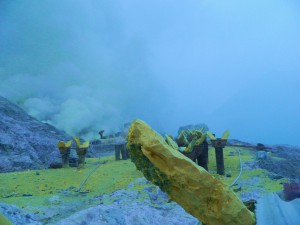 In the early hours we already met a couple of them marching uphill with their empty baskets. When we had made it up the forest path and through the sulfur-heavy air still before sunrise, we were rewarded by an incredible view of the smoking crater spilling its yellow treasure. The workers stood in the middle of the smoke, breaking the sulfur with iron bars and loading it into the baskets with their bare hands.
In the early hours we already met a couple of them marching uphill with their empty baskets. When we had made it up the forest path and through the sulfur-heavy air still before sunrise, we were rewarded by an incredible view of the smoking crater spilling its yellow treasure. The workers stood in the middle of the smoke, breaking the sulfur with iron bars and loading it into the baskets with their bare hands.
Most amazing were the blue flames of burning sulfur at the point where the substance emerges in liquid form from the earth and solidifies. These flames are hardly visible in daylight and complete a stunning and unforgettable scenery of yellow rock, the crater lake, the noise and smell of the acidic smoke and the moonlit crater walls.
and a happy New Year! Thanks for reading our blog and all the best from Indonesia.
We miss you!

 Mount Bromo is one of the three holy mountains for Indonesian Hindus and also a main tourist attraction in Java. According to the legend, a childless Hindu queen prayed to the volcano god for children, and got 25 of them. The last one sacrificed himself by jumping into the crater in order to thank the god.
Mount Bromo is one of the three holy mountains for Indonesian Hindus and also a main tourist attraction in Java. According to the legend, a childless Hindu queen prayed to the volcano god for children, and got 25 of them. The last one sacrificed himself by jumping into the crater in order to thank the god.
We made our way to Bromo from the town of Probolinggo and – as a lot of others – got up very early in the morning to see Bromo and the landscape from the Penanjakan viewpoint at sunrise. Despite the crowd the experience was great, especially avoiding the offered expensive Jeep transport that will only take you when and where all others go and that will not save you from climbing the steep part anyway.
To see the crater from close-by, best is to hike to Bromo in late afternoon when you have it almost to yourself. The volcano lies in a landscape scattered with other volcanoes, on a plain of grey ash that offers views into the surrounding green Javan fields and mountains. We decided that we love volcanoes and moved straight on to the next one, Kawah Ijen.
best is to hike to Bromo in late afternoon when you have it almost to yourself. The volcano lies in a landscape scattered with other volcanoes, on a plain of grey ash that offers views into the surrounding green Javan fields and mountains. We decided that we love volcanoes and moved straight on to the next one, Kawah Ijen.
-
 Passing through a beautiful Javanese landscape of fertile rice fields and small villages ringed by mountains and volcanoes, our train finally reached Yogyakarta. Still headed by its sultan, Yogya is Java’s cultural capital. The historic palace with halls, pavillions and spacious courtyards remains the hub of traditional life.
Passing through a beautiful Javanese landscape of fertile rice fields and small villages ringed by mountains and volcanoes, our train finally reached Yogyakarta. Still headed by its sultan, Yogya is Java’s cultural capital. The historic palace with halls, pavillions and spacious courtyards remains the hub of traditional life.
We enjoyed some slower and easy-going days in the colourful city and the green region known for tofu, woodcarvings, ceramics and batik.
Considered one of Asia’s most spectacular archaeological sites, we were curious to see the temple of Borobudur. Built about 1,200 years ago from 60,000 cubic meters of stone, it is said to be as impressive as Cambodia’s Angkor Wat.
 The two million stone blocks are structured in ten levels that each represent a different passage of the soul from Earth to heaven. A clockwise walk will take you through narrow corridors showing carved panels of Buddha’s incarnations and various aspects of Javanese life, finally leading to the bell-shaped stupas on the top three levels. Viewed from the sky, Borobudur resembles a tantric mandala – conceived as a Buddhist vision of the cosmos in stone.
The two million stone blocks are structured in ten levels that each represent a different passage of the soul from Earth to heaven. A clockwise walk will take you through narrow corridors showing carved panels of Buddha’s incarnations and various aspects of Javanese life, finally leading to the bell-shaped stupas on the top three levels. Viewed from the sky, Borobudur resembles a tantric mandala – conceived as a Buddhist vision of the cosmos in stone.
It all sounds amazing, but to be honest, we were a bit disappointed, especially comparing to Angkor. The temple is certainly nice, but it somehow lacked the advertised magnificience, and maybe due to the World Heritage status, access is overpriced.
 Our last stop in Sulawesi was Manado, known for its adventurous cuisine. It’s said that the Minahasan people will eat anything on four legs, apart from tables and chairs. That’s why we were not even surprised to see bat and chopped dog among the food on display. A macabre daily market nearby proved us right – it was full of dead and alive dogs in cages, pigs, grilled rats, all situated in a stunning setting below Gunung Lokon volcano.
Our last stop in Sulawesi was Manado, known for its adventurous cuisine. It’s said that the Minahasan people will eat anything on four legs, apart from tables and chairs. That’s why we were not even surprised to see bat and chopped dog among the food on display. A macabre daily market nearby proved us right – it was full of dead and alive dogs in cages, pigs, grilled rats, all situated in a stunning setting below Gunung Lokon volcano.
Manado was no highlight, and it got worse in Surabaya on Java, where we found ourselves in the ugliest city of the world! Pampered after so many pretty islands, white beaches and colourful sunsets it was quite a difference. We fought our way through the smog, dirt, stench, traffic and survived a ride with a suicidal bus driver, who overtook lorries at full speed on the emergency lane and beyond.
In Surabaya, we visited the factory of one of Indonesia’s most famous cloves-flavoured cigarette manufacturers. Their sweet, spicy scent is everywhere in the air, like a toxic national perfume. They account for 90% of the cigarette market and are banned from most countries as the tar content is so strong. The addiction is nationwide – two thirds of all men smoke at a rate of 3,000 cigarettes a year and they start very young, sometimes at the age of five.
The museum is at the same ti me still a production site, where hundreds of women hand roll, trim and pack cigarettes. The abrupt movements reminded of a monochrome film – the fastest rollers are said to crank out 4,000 cigarettes a day! We ended the day in the charming Arab quarter, tried some Muslim food and listened to the muezzins inviting to join for prayers in one of the many nearby mosques.
me still a production site, where hundreds of women hand roll, trim and pack cigarettes. The abrupt movements reminded of a monochrome film – the fastest rollers are said to crank out 4,000 cigarettes a day! We ended the day in the charming Arab quarter, tried some Muslim food and listened to the muezzins inviting to join for prayers in one of the many nearby mosques.
-
 It began with the alarm at two a.m. We were the first to tackle the ascent from Pos Paltuding to Kawah Ijen, active volcano crater and source of raw sulfur in east Java.
It began with the alarm at two a.m. We were the first to tackle the ascent from Pos Paltuding to Kawah Ijen, active volcano crater and source of raw sulfur in east Java. In the early hours we already met a couple of them marching uphill with their empty baskets. When we had made it up the forest path and through the sulfur-heavy air still before sunrise, we were rewarded by an incredible view of the smoking crater spilling its yellow treasure. The workers stood in the middle of the smoke, breaking the sulfur with iron bars and loading it into the baskets with their bare hands.
In the early hours we already met a couple of them marching uphill with their empty baskets. When we had made it up the forest path and through the sulfur-heavy air still before sunrise, we were rewarded by an incredible view of the smoking crater spilling its yellow treasure. The workers stood in the middle of the smoke, breaking the sulfur with iron bars and loading it into the baskets with their bare hands.
